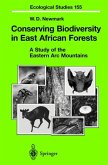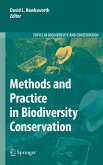This book brings together a selection of 21 original studies submitted to Biodiversity and Conservation that address aspects of management for the conservation of biodiversity. The topics addressed include: lessons from the Northern spotted owl saga, hidden costs of implementing the EU Habitats Directive, the importance of recently created agricultural wetlands, cutting reeds to create a sustainable habitat, impacts and control of feral cats, selecting areas to complement existing reserve systems, beneficial effects of rabbit warrens, effects of fences on large predator ranges, spatial structure of critical habitats and connectivity, effects of an agro-pasture landscape on biodiversity, community involvement, reserve selection in forests, germ-plasm interventions in agroforestry systems, shade coffee plantations and the protection of tree diversity, reserves and the reduction of deforestation rates in dry tropical forests, reconciling forest conservation actions with usage byand needs of local peoples, weed invasion in understory plant communities in tropical lowland forests, problems of patch area and connectivity in plant conservation, the need not to focus just on hot-spots, and partitioning conservation across elevations.
The organisms and communities considered embrace birds, coral reefs, various large and small mammals, reptiles, forest trees, and dune and boreal semi-natural grassland plants. The contributions are taken from situations being confronted in regions including the Andaman Islands, Brazil, Canary Islands, the Caribbean, Finland, Germany, Guinea, India, Italy, Mexico, Myanmar, Poland, South Africa, Spain, and the USA.
Collectively, the studies presented here provide a snap-shot of the types of management actions being undertaken for conservation and their efficacy. This makes the volume especially valuable for use in conservation biology courses.
Reprinted from Biodiversity and Conservation, volume 18, No 4 (2009)
The organisms and communities considered embrace birds, coral reefs, various large and small mammals, reptiles, forest trees, and dune and boreal semi-natural grassland plants. The contributions are taken from situations being confronted in regions including the Andaman Islands, Brazil, Canary Islands, the Caribbean, Finland, Germany, Guinea, India, Italy, Mexico, Myanmar, Poland, South Africa, Spain, and the USA.
Collectively, the studies presented here provide a snap-shot of the types of management actions being undertaken for conservation and their efficacy. This makes the volume especially valuable for use in conservation biology courses.
Reprinted from Biodiversity and Conservation, volume 18, No 4 (2009)








